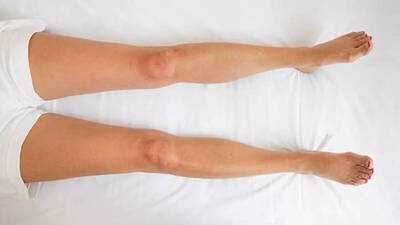If you have been suffering from frequently swollen legs and feet, then it's time to realise that they are signalling you to pay attention to your health. Many think of pain in the legs, ankles, and feet as a result of aging or heavy exercising, but if you have them frequently, then the reasons could be varied, from liver disease to heart disease and more. Find out below!
Chronic Vein Insufficiency (CVI) or Varicose Veins
Since humans stand on their two feet, the entire weight of the blood volume is exerted on the veins in the legs due to gravity. The valves in the veins help counteract this force, keep the blood pressure low and help the blood return to the heart. However, over time, their performance can decrease, thus leading the blood to flow backwards. Thus, venous insufficiency can lead to symptoms such as blood pooling, swelling, varicose veins, or even cramping.
Heart issues
The heart is connected to every part of the human body. As mentioned above, the blood from the legs flows to and from the heart. In case the organ isn't functioning well, it can lead to pooling of blood in the legs and thus cause swelling and pain. Other symptoms that you can be on the lookout for to confirm heart disease are chest pain, shortness of breath, fast heartbeat and more.
Deep Vein Thrombosis (DVT)
The presence of a blood clot in the veins obstructs the flow of blood, and this condition is known as deep vein thrombosis. This can cause swelling, pain, tenderness and redness in the vein and legs. A DVT prevents the blood from easily flowing through the leg, leading to pressure build-up and forcing the fluids to move into the surrounding tissues. If it breaks, it can travel to the lungs and cause a fatal condition called pulmonary embolism. Thus, visit the doctor if you see any such symptoms immediately.
Liver or kidney issues
Chronic liver issues can lead to a buildup of fluid in the legs and abdomen and are typically accompanied by other symptoms such as yellow skin, redness in palms, or pale-coloured stools. Whereas, kidney issues can be signalled through swelling and pain in the lower extremities, fatigue, frequent trips to the bathroom and disturbed concentration.
Lymphedema
Accumulation of fluid in the lymphatic system can affect the arms and legs with swelling in the tissues. These include difficulty in moving the leg, skin infections and more and need to be checked by a professional.
Infection
When bacteria infect the deep layers of the skin and the tissues under it, they cause an infection called Cellulitis . It causes about 14.5 million cases in the US annually, according to the American Academy of Dermatology. One of the first symptoms of the infection is swelling in the legs, particularly in the feet, accompanied by redness and warm skin.
Chronic Vein Insufficiency (CVI) or Varicose Veins

Since humans stand on their two feet, the entire weight of the blood volume is exerted on the veins in the legs due to gravity. The valves in the veins help counteract this force, keep the blood pressure low and help the blood return to the heart. However, over time, their performance can decrease, thus leading the blood to flow backwards. Thus, venous insufficiency can lead to symptoms such as blood pooling, swelling, varicose veins, or even cramping.
Heart issues
The heart is connected to every part of the human body. As mentioned above, the blood from the legs flows to and from the heart. In case the organ isn't functioning well, it can lead to pooling of blood in the legs and thus cause swelling and pain. Other symptoms that you can be on the lookout for to confirm heart disease are chest pain, shortness of breath, fast heartbeat and more.
Deep Vein Thrombosis (DVT)

The presence of a blood clot in the veins obstructs the flow of blood, and this condition is known as deep vein thrombosis. This can cause swelling, pain, tenderness and redness in the vein and legs. A DVT prevents the blood from easily flowing through the leg, leading to pressure build-up and forcing the fluids to move into the surrounding tissues. If it breaks, it can travel to the lungs and cause a fatal condition called pulmonary embolism. Thus, visit the doctor if you see any such symptoms immediately.
Liver or kidney issues
Chronic liver issues can lead to a buildup of fluid in the legs and abdomen and are typically accompanied by other symptoms such as yellow skin, redness in palms, or pale-coloured stools. Whereas, kidney issues can be signalled through swelling and pain in the lower extremities, fatigue, frequent trips to the bathroom and disturbed concentration.
Lymphedema
Accumulation of fluid in the lymphatic system can affect the arms and legs with swelling in the tissues. These include difficulty in moving the leg, skin infections and more and need to be checked by a professional.
Infection
When bacteria infect the deep layers of the skin and the tissues under it, they cause an infection called Cellulitis . It causes about 14.5 million cases in the US annually, according to the American Academy of Dermatology. One of the first symptoms of the infection is swelling in the legs, particularly in the feet, accompanied by redness and warm skin.
You may also like

Canada's arms shipments to Israel continue despite official freeze, shows data; records reveal ammo and parts sent

Bryan Mbeumo ready to show up Man Utd rejects with nine-word comment Ruben Amorim will love

Karnataka govt to host Nobel laureates for landmark 'Quantum Dialogue' tomorrow

Russia issues horror nuclear annihilation warning - 'patience is running out'

Patrick Kielty's TV future confirmed after Cat Deeley split as RTE issue statement





